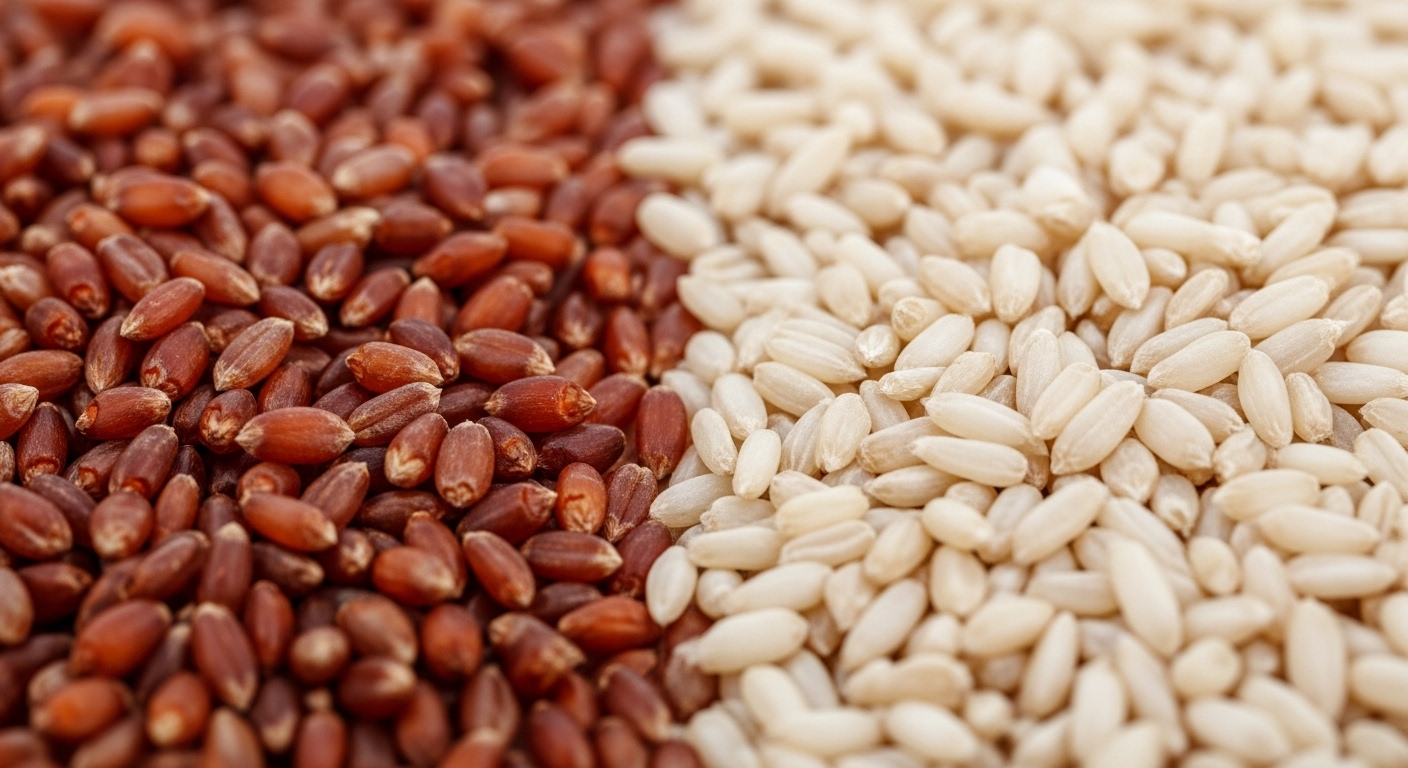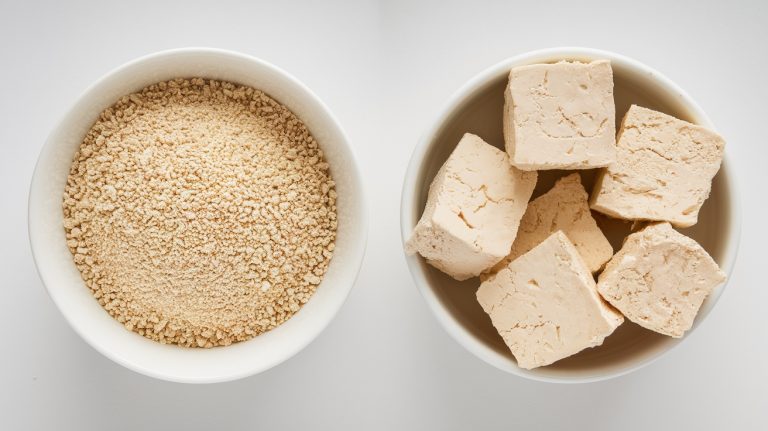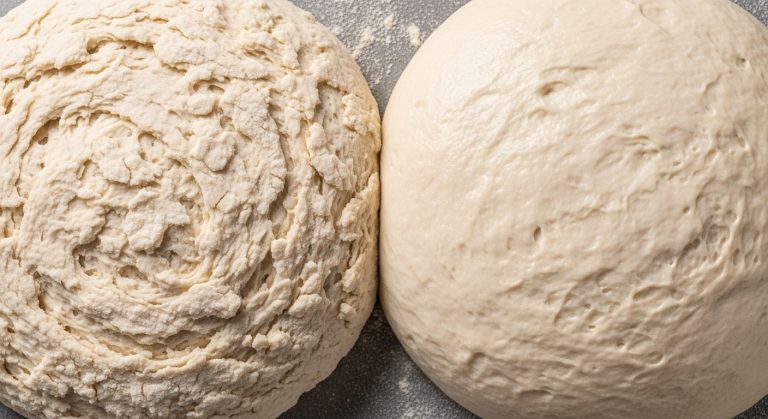Red vs White Wheat: Your Grain Selection Strategy
When choosing between red and white wheat, you’re making a decision that impacts everything from your nutritional intake to your baking success.
Red wheat delivers superior protein content (12.6g vs 11.3g per 100g), higher fiber levels, and enhanced antioxidant protection through phenolic compounds, making it ideal for hearty breads and health-conscious consumers.
Meanwhile, white wheat offers a milder, sweeter flavor with softer texture, perfect for delicate pastries and sensitive digestion. This comprehensive guide reveals the nutritional differences, culinary applications, and health benefits that will transform how you approach wheat selection.
Whether you’re optimizing your diet for immune support or perfecting your baking technique, understanding these distinctions unlocks the secret to choosing the right wheat for your specific needs and goals.
Key Takeaways
- Red wheat contains higher protein, fiber, iron, zinc, and antioxidants than white wheat, supporting better nutrition and immune health.
- White wheat has a milder, sweeter taste with a softer texture, ideal for delicate baked goods and sensitive digestion.
- Red wheat’s robust flavor and higher gluten make it perfect for hearty breads and nutrient-dense recipes.
- White wheat undergoes more processing, reducing minerals and phenolic compounds compared to nutrient-rich red wheat.
- Red wheat thrives in harsher climates with better disease resistance, while white wheat prefers milder growing conditions.
Comparison Table of Red vs White Wheat
| Aspect | Red Wheat | White Wheat |
|---|---|---|
| Protein Content | 12.6g per 100g – Higher protein supporting stronger gluten development | 11.3g per 100g – Lower protein with softer gluten structure |
| Fiber Content | Higher dietary fiber – Promotes digestive health and blood sugar regulation | Lower fiber due to bran removal – Results in softer texture |
| Mineral Profile | Rich in iron, zinc, magnesium, manganese, selenium – Supports immune function and metabolic health | Lower mineral content due to processing – Still contains essential nutrients |
| Vitamin Content | Higher B3, B6, niacin – Supports DNA repair and inflammation regulation | Reduced vitamins from processing – Adequate for basic nutrition |
| Antioxidant Levels | Higher phenolic compounds, anthocyanins, flavonoids – Superior antioxidant capacity | Lower phenolic content – Milder antioxidant properties |
| Flavor Profile | Robust, nutty, earthy with subtle bitterness from tannins | Milder, sweeter taste – No bitterness |
| Texture in Baking | Dense, chewy texture – Firm structure for hearty breads | Fine, soft crumb – Lighter mouthfeel for delicate pastries |
| Best Culinary Uses | Hearty breads, pasta, nutrient-dense dishes requiring strong structure | Cakes, pastries, delicate baked goods needing gentle texture |
| Cooking Properties | Requires more water – Longer cooking time | Cooks faster – Requires less water |
| Visual Appearance | Reddish hue in baked goods from natural pigments | Lighter color – Neutral appearance |
| Digestibility | Higher fiber may be challenging for sensitive digestion | Easier to digest – Suitable for sensitive stomachs |
| Growing Conditions | Thrives in harsh climates – Better disease resistance | Prefers milder conditions – More environmentally sensitive |
| Health Benefits | Enhanced immune support, better digestive health, higher antioxidant protection | Gentler on digestion, suitable for those preferring milder flavors |
| Caloric Content | Similar caloric values – Energy mainly from carbohydrates | Similar caloric values – Energy mainly from carbohydrates |
| Shelf Life in Baking | Longer-lasting freshness due to higher protein and fiber | Shorter shelf life – Quicker staling |
Nutritional Differences Between Red and White Wheat
While both red and white wheat offer valuable nutrients, red wheat consistently provides higher levels of key vitamins and minerals such as iron, zinc, niacin, and vitamin B6, which play critical roles in immune support and metabolic function.
The diverse microbial communities involved in fermentation can interact differently with wheat varieties, potentially influencing flavor and nutritional outcomes through microbial diversity.
Red wheat offers higher iron, zinc, niacin, and vitamin B6, vital for immunity and metabolism.
You’ll find red wheat’s darker bran contains more phenolic compounds and tannins, enhancing antioxidant capacity and mineral bioavailability. White wheat, lacking these bran color genes, tends to have lower phenolic content and milder taste.
Magnesium levels remain abundant in both, supporting muscle and nerve functions. Processing reduces minerals and vitamins more in white wheat due to bran removal, diminishing its nutrient density. Additionally, red wheat’s higher fiber content supports digestive health and blood sugar regulation, making it a more beneficial choice for overall wellness high fiber content.
Hence, when you prioritize micronutrient intake, particularly for immune and metabolic health, red wheat presents a superior nutritional profile compared to white wheat, based on current compositional evidence.
Comparing Macronutrients in Red and White Wheat
Red and white wheat differ not only in micronutrient content but also in their macronutrient profiles, which directly influence their functional and nutritional applications. When comparing the two, consider these key aspects:
- Protein Content: Hard red wheat contains about 12.6 g protein per 100 g, higher than white wheat’s 11.3 g, affecting gluten strength and suitability for bread requiring strong structure. Its higher gluten content contributes to strong gluten development and elasticity, which is essential for chewy and hearty baked goods. This property makes red wheat particularly favored in recipes that require a firm dough structure.
- Carbohydrates and Fiber: White wheat has slightly more carbohydrates but less dietary fiber due to bran removal, making its flour finer and baked goods softer. This lower fiber content results in a smoother texture and milder taste, ideal for lighter baked items. The reduced fiber also means white wheat flours often need adjustments in hydration during baking. Red wheat’s higher fiber contributes to denser textures and better digestive support.
- Energy Provision: Both provide similar caloric values mainly from carbohydrates, but the fiber and protein differences impact texture and functional properties in food processing.
These macronutrient distinctions guide your choice depending on baking needs and nutritional goals.
Health Benefits of Red Wheat Over White Wheat
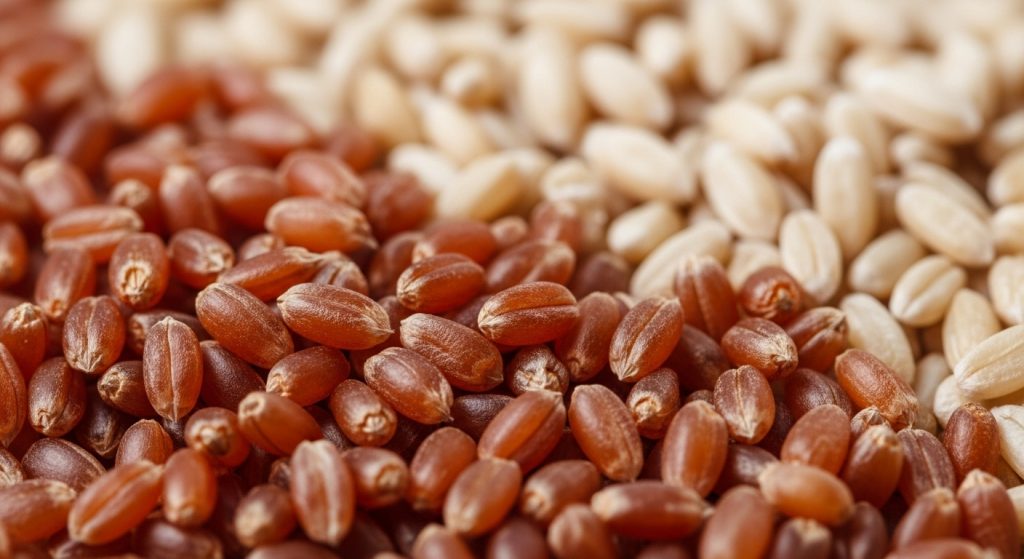
You’ll find red wheat offers higher antioxidant levels, including anthocyanins and flavonoids, which help reduce oxidative stress and inflammation. These antioxidants are often preserved better in whole grains, complementing the benefits found in organic ingredients used in quality baking kits.
Its elevated iron and zinc content supports stronger immune function compared to white wheat.
Additionally, red wheat’s greater fiber concentration promotes digestive health by regulating blood sugar and improving gut function. This is particularly important because whole grains like red wheat help stabilize blood sugar levels and reduce symptoms such as mental fog and cravings.
Antioxidant Advantages
Because it contains higher levels of phenolic compounds such as phenolic acids, flavones, and flavonols, red wheat offers superior antioxidant capacity compared to white wheat. You’ll find red wheat has stronger free radical neutralizing ability, demonstrated by higher DPPH radical scavenging activity.
This is largely due to the fact that bound phenolics constitute about 90% of total phenolics in wheat, making them the dominant source of antioxidant activity. Its natural components contribute to reducing waste and improving overall kitchen efficiency.
Additionally, its elevated iron and zinc content supports antioxidant enzymes like catalase and superoxide dismutase, enhancing cellular defense against oxidative stress. Here are key advantages:
- Higher phenolic content increases antioxidant potency, reducing oxidative damage effectively.
- Enhanced mineral profile (iron, zinc) optimizes endogenous antioxidant enzyme function.
- Diverse flavonoids and tannins provide broader antioxidative effects beyond basic phenolics.
Enhanced Immune Support
Although both red and white wheat provide essential nutrients, red wheat delivers enhanced immune support due to its superior mineral, vitamin, protein, and phenolic profiles. Its elevated iron, zinc, magnesium, manganese, and selenium contents bolster enzyme functions, antioxidant defenses, and immune cell activity, critical for infection resistance.
Furthermore, red wheat provides a substantial amount of zinc, supplying about 29% of daily needs per half cup, which significantly enhances the body’s ability to fight infections immune system support. Bread makers with temperature control features help maintain nutrient integrity during baking, further preserving these immune-supporting compounds.
Red wheat’s higher B3 and B6 vitamins facilitate DNA repair, lymphocyte proliferation, and inflammation regulation, optimizing immune responses. Additionally, its increased protein supplies amino acids indispensable for antibody production, cytokine synthesis, and tissue repair during immune challenges.
The abundant phenolic compounds in red wheat neutralize oxidative stress and modulate inflammatory pathways, enhancing immune regulation and antiviral defense. Collectively, these factors confer red wheat a measurable advantage in supporting and maintaining robust, balanced immune function compared to white wheat.
Superior Digestive Health
When seeking to optimize digestive health, red wheat offers distinct advantages over white wheat due to its higher dietary fiber content, enriched protein levels, and superior mineral composition.
Red wheat’s bran layer provides insoluble fiber, enhancing stool bulk and promoting bowel regularity. This whole grain also contains a range of essential nutrients including B vitamins, iron, and magnesium that contribute to overall digestive well-being.
Its elevated protein supports gastrointestinal tissue repair, while minerals like magnesium, zinc, and iron optimize enzymatic digestion and gut muscle function. Additionally, antioxidants in red wheat reduce oxidative stress and inflammation, fostering a healthier gut environment.
Precision in measuring dietary intake, such as fiber and minerals, can help maximize these benefits when preparing whole grain dishes with a digital kitchen scale.
Key benefits include:
- Enhanced fiber intake improves gut motility and microbiota balance.
- Superior mineral content supports enzymatic activity and tissue regeneration.
- Antioxidants lower inflammation and protect digestive tissues.
Choosing red wheat supports sustained digestive efficiency and long-term gut health more effectively than white wheat. Moreover, the presence of phenolic acids and flavonoids in red wheat contributes to reducing chronic inflammation linked to digestive disorders.
Culinary Uses and Flavor Profiles
If you want to choose the right wheat for your culinary project, understanding the distinct uses and flavor profiles of red and white wheat is essential.
Red wheat, with its high protein content, supports strong gluten development, making it ideal for hearty breads and pasta that require a chewy texture and firm structure. Its robust, nutty flavor with earthy undertones complements rich, savory dishes and adds a reddish hue to baked goods. Because of its higher protein content, red wheat is especially suited for bread-making.
Red wheat’s high protein and robust flavor make it perfect for chewy breads and savory dishes.
Conversely, white wheat offers a milder, sweeter taste and softer texture, making it preferable for delicate baked goods like cakes and pastries. It cooks faster and requires less water, suited for lighter breads and dishes needing gentler chew.
Agricultural and Environmental Variations
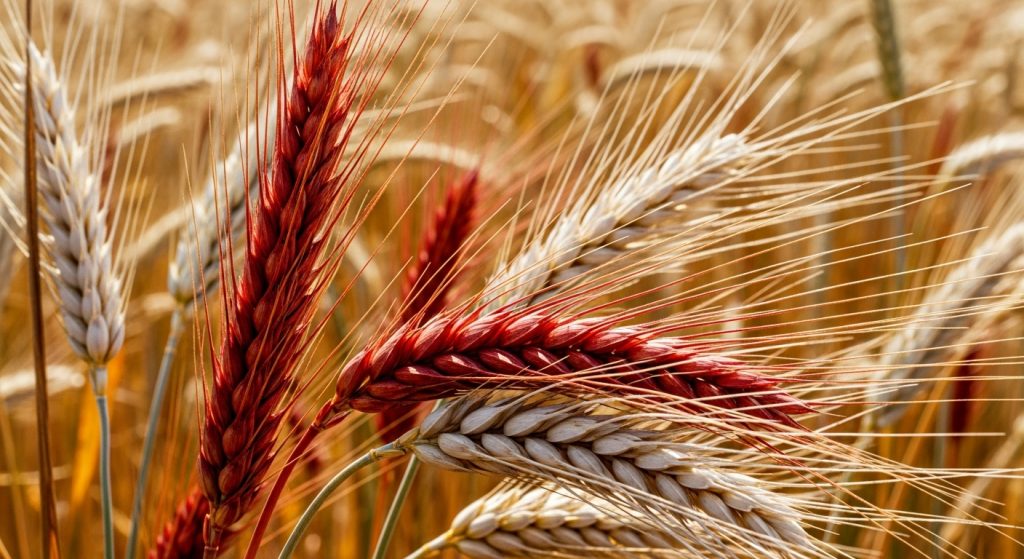
Understanding the agricultural and environmental variations between red and white wheat is essential for optimizing cultivation strategies and crop performance. You’ll find that red wheat, especially hard red winter varieties, thrives in harsher climates like the Great Plains due to stronger disease resistance and genetic improvements boosting yield.
White wheat prefers milder conditions but demands precise harvest timing to avoid sprouting and quality loss. Key considerations include:
- Regional adaptability: Red wheat suits colder, variable moisture regions; white wheat favors milder climates with less temperature fluctuation.
- Disease resistance: Red wheat shows enhanced resistance to late-season diseases, while white wheat is more susceptible, requiring careful management.
- Soil and climate: Red wheat’s higher protein content partly results from adaptation to nutrient-rich or water-stressed soils, contrasting with white wheat’s softer texture and environmental sensitivity.
Additionally, just as different wheat types require careful management for optimal results, baking mixes like Krusteaz’s sourdough bread mix demonstrate how yeast activity and ingredient freshness are critical for achieving desired quality in related grain-based products.
Consumer Preferences and Dietary Needs
You’ll find red wheat offers higher protein and fiber levels, supporting muscle repair and digestive health. Its stronger flavor suits traditional whole wheat products. White wheat provides a milder taste and softer texture preferred for delicate baked goods.
Your nutritional priorities influence whether you choose red wheat’s robust nutrient profile or white wheat’s gentler flavor and digestibility. Health-conscious consumers often weigh these factors to match their dietary needs and culinary preferences precisely. Understanding the differences in dough types can also help tailor baked goods to specific texture and flavor outcomes.
Nutritional Priorities
When selecting between red and white wheat, you should contemplate how their nutritional profiles align with your dietary priorities and health goals. Red wheat offers about 12% protein—higher than white wheat’s 10%—supporting muscle repair and maintenance. It also provides greater dietary fiber, enhancing digestive health and glycemic control.
Additionally, red wheat contains elevated levels of iron, zinc, and antioxidants, which contribute to immune support and reduce oxidative stress.
Key nutritional distinctions to consider:
- Protein & Fiber: Red wheat supports muscle health and digestion better.
- Micronutrients: Red wheat supplies more iron, zinc, and B vitamins critical for metabolic functions.
- Antioxidants: Red wheat’s phenolic compounds aid chronic disease risk reduction.
Moreover, the choice of wheat can influence the texture and flavor of sourdough breads, with whole-grain varieties like red wheat offering a denser texture and more complex taste.
Taste and Texture
How do taste and texture differences between red and white wheat influence consumer choices and dietary applications? You’ll find red wheat offers a robust, nutty flavor with subtle bitterness from tannins, paired with a denser, chewier texture due to its bran content. This profile suits hearty breads and bold-flavored recipes, appealing to consumers who prefer rustic, full-bodied products.
Additionally, red wheat berries are often preferred in yeast breads because of their high protein content, which enhances gluten formation and bread structure. Its denser bran content also contributes to longer-lasting freshness in baked goods, a key factor in consumer satisfaction and product durability.
In contrast, white wheat provides a milder, sweeter taste without bitterness and yields baked goods with a finer, softer crumb. Its lower protein and bran content result in less gluten development and a lighter mouthfeel, favored for delicate pastries and cakes. This difference in texture and softness aligns well with consumer preferences for visually appealing and tender baked products that require less intensive mixing and kneading.
These distinctions guide you in selecting wheat types based on desired taste intensity, crumb structure, and dietary needs, ensuring product acceptability across diverse palates and baking applications.
Health-Conscious Choices
Although both red and white wheat provide essential macronutrients, their distinct protein, fiber, and micronutrient profiles influence health-conscious consumer choices and dietary applications. Red wheat offers higher protein (12–12.6%) and fiber, supporting tissue repair and digestive health, while white wheat has a softer texture with slightly lower fiber.
Micronutrient differences include red wheat’s richer iron, zinc, magnesium, and B vitamins, which enhance immune and metabolic functions.
Consider these key points when choosing wheat for your diet:
- Red wheat’s higher protein and fiber benefit those targeting muscle maintenance and blood sugar regulation.
- White wheat suits sensitive digestion due to its lower fiber and milder flavor.
- Antioxidants in red wheat may provide added protection against oxidative stress and chronic disease.
Choosing Between Red and White Wheat for Your Diet
Since nutritional goals vary, choosing between red and white wheat requires understanding their distinct macronutrient profiles and health impacts.
Red wheat offers higher protein (12–12.6%) and dietary fiber, enhancing satiety, digestion, and glycemic regulation—beneficial if you prioritize nutrient density and metabolic health. It also provides greater amounts of iron, zinc, B3, B6, and antioxidants like phenolic compounds, which support immune function and reduce oxidative stress.
Red wheat’s higher protein and fiber promote satiety and metabolic health, plus it’s rich in essential minerals and antioxidants.
Conversely, white wheat contains about 10% protein and less fiber due to bran removal, resulting in faster cooking and a milder flavor, which may suit those with sensitive digestion or preference for delicate baked goods.
Both wheats supply essential vitamins and minerals, so your choice should align with your specific protein needs, digestive tolerance, and culinary applications to optimize dietary outcomes effectively.
Frequently Asked Questions
How Do Red and White Wheat Differ in Baking Shelf Life?
You’ll find that wheat with higher protein and fiber content generally extends baked goods’ shelf life by maintaining firmness and moisture. When flour contains more gluten, it preserves dough structure and slows moisture loss, which helps freshness.
Softer wheat flour absorbs less water and leads to quicker staling, shortening shelf life. So, choosing wheat based on protein, fiber, and gluten content directly impacts how long your baked products stay fresh.
Are There Differences in Gluten Sensitivity Between Red and White Wheat?
Gluten sensitivity varies based on individual immune response and gluten quantity, not wheat color alone. You might find white wheat somewhat easier to digest due to its lower gluten content and softer gluten structure, but both wheat types contain gluten that can trigger symptoms like bloating and abdominal pain.
If you have celiac disease or severe gluten intolerance, you should avoid all gluten-containing grains regardless of type, as no wheat is completely safe for you.
What Are the Historical Origins of Red Versus White Wheat?
Think of wheat’s history as a layered tapestry woven over centuries. You’ll find white wheat originated from early southern U.S. varieties like White May, valued for mild flavor and light flour.
Red wheat traces back to crosses such as Red May, blending traits from English Yellow Lammas and White May, emphasizing robustness and disease resistance. These lines reflect targeted breeding to balance flavor, yield, and adaptation to local soils and climates.
Can Red or White Wheat Be Used Interchangeably in Beer Brewing?
You can use red or white wheat interchangeably in brewing without changing your milling or mashing process since their enzymatic activity and hydration are similar.
However, expect shifts in flavor and color—red wheat yields a more robust, astringent profile with deeper hues, while white wheat offers cleaner, milder notes and lighter color.
Your choice depends on availability and the specific sensory outcome you want in your beer.
How Do Storage Conditions Affect Red and White Wheat Quality?
Storage conditions impact wheat quality like a thermostat controls a home’s comfort. You must keep moisture below 10% to avoid chemical degradation and mold growth, which spike above 12% and 15%, respectively.
Store wheat at 40-60°F to slow spoilage; warmer temperatures accelerate deterioration. Use airtight, dark containers with oxygen absorbers to minimize oxygen and pests.
These steps preserve protein content and prevent kernel damage, ensuring ideal wheat quality over time.
Health-Conscious Baking Starts with the Right Wheat
When choosing between red and white wheat, you’ll find each offers unique nutritional and culinary benefits backed by research. Red wheat tends to have higher antioxidant levels, while white wheat often boasts a milder flavor suited for various recipes.
Remember, the proof is in the pudding—your dietary needs and taste preferences should guide your choice. By understanding these differences, you can make an informed decision that supports both your health and palate.

